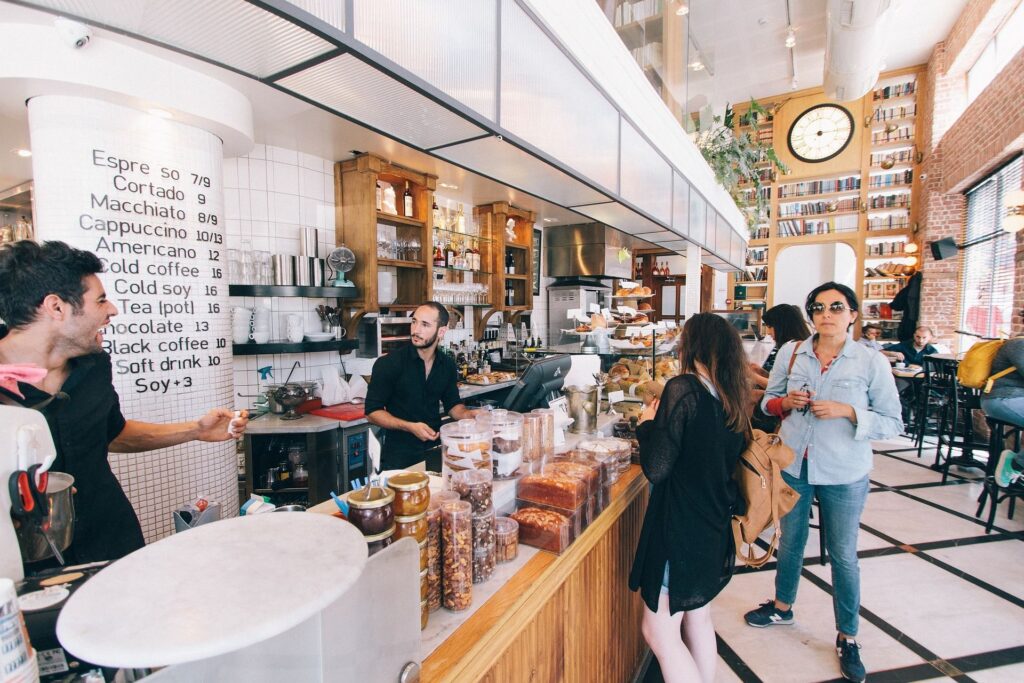
Meet Jenn Donovan. With over 15 years industry experience, Jenn really knows how to use marketing as an effective tool to help a business to grow. Jenn is a successful author and podcaster, as well as an experienced keynote speaker. She also runs workshops and one-to-one coaching sessions, spending time with small and medium-size business owners to develop successful marketing strategies.
Jenn loves providing business owners with the tools they need to develop their own brand presence through powerful marketing. Yes, consistent sales are the cornerstone of any business, but marketing gets your name out there. It’s a combination that works hand-in-hand: good marketing drives sales, and sales strengthen your marketing process. These days, a dynamic marketing strategy is vital to long-term financial success.

Afterall, these are the ones pulling on the purse strings. The most common reason behind why a customer will turn their back on a business? It might not be what you’d think! Data tells us that:
68% of customers turn their back on a business because they believe the company genuinely cares about them.
Despite many business owners focusing on ‘good customer service’, it turns out that parting ways over a negative experience accounts for just 14% of consumers – almost five times as many customers will cease to buy from a business due to a belief that the company doesn’t really value them.
In this Q&A, we’re talking to Jenn about the importance of looking after your customers and why there’s value in making them feel valued! Read on to find out why it’s so important for a business to reach out to their community, plus discover her 9 top tips on ways to make that important personal connection and hold on to it long-term.
Welcome Jenn!
Hi everyone, so to kick off – my number one tip would be to stop having that relationship with your customer that’s purely based on money. When a customer feels as though the only contact they receive from a business is a request to purchase something, they begin to feel a negativity when this company communicates with them, such as an email, text or phone call.
when I had my retail business, which was a kitchenware shop, we would send out a regular email that always included a ‘product of the week’, ‘recipe of the week’ and a ‘cooking tip of the week’ – I can guarantee you that many people opened it simply to read tips, nothing else!
In one edition, our ‘cooking tip of the week’ was “Get your wooden spoon and you dip it into boiling hot water and smell it; if it smells off, then it’s got germs, it’s time for a new wooden spoon.” Guess what the product of the week was? Our range of wooden spoons!
So we did make the sales we wanted, but we didn’t do it through a ‘hard sell’ technique. People didn’t feel like they were being sold to, but they definitely were. and what we gained was great for our community – on our social media platforms, people began posting about it and it became the start of a big conversation.
Where are the opportunities within your customer relationships that you could show your customer that you care for them?
Maybe it’s a conversation you had with them, and the next time you make contact, you take an five extra minutes to pick up where you left off last time. Ask how they’re going, or if you remember something they referred to, like a family member not being well, you could bring it up and ask “How is your mum?”
It’s just looking for those 1% things that you can do that just makes your relationships a little bit more personal. It mightn’t be feasible to every customer or client, but over a twelve-month period you’d be amazed at how many deeper connections you have made if it’s a regular part of your customer relations strategy.

There’s an old saying, ‘people come for the content, but they stay for the community’, so they come for your product, but then they hang around because you’ve created a community of like-minded people.
Once you have a community in place, it’s about finding ways to steer their attention to get conversations started. Yes, they’ve all come together because they like the jam you make, as an example. But, use your socials to point out that a certain group of individuals all bought your jam at the same particular place and time. Suddenly you’ve created a tangible narrative for people to make connections.
Think about where you give people an opportunity to network or to interact with each other or to talk about your product. Set up a dedicated Facebook group or organise a ‘VIP night’ that you put on once a year to celebrate how the year’s gone with all your loyal customers.
This one that does take work but cultivating a community does take extra work. Do ask yourself the question, “How much extra will I get through my business if I put on this event?” Or “What will that online social media group do for my business in a positive way?” Because of course we are in business to make money, let’s not make bones about it. But I feel that these are a really good way of connecting and having your customers connect with each other.
Make yourself easy to buy from – if I had a highlighter and I could use capital letters, this would be the one that I would do it for! This is where business owners often fall down – they do marketing campaigns and pique the customer’s interest, but then a button on the website doesn’t work and there’s a break in the chain so the customer logs off.
My biggest bug bear is when a business showcases beautiful products on Instagram, but then the link goes through to the company website. So the customer journey is made clunkier and slower – and they’re thinking “Why do I need to go to your website and find the product for a second time? I could have clicked and gone directly to the product and bought it.” In many of these instances the customer gives up, it’s just too hard to buy from you.
The same idea is true at in-person events and expos. Many stands are ill-equipped for proper representation and often understaffed. You may have great product, and you get a lot of attention, and yet, if there’s no one available to talk to, how can you make that connection or sale? Think about ways to solve these issues, perhaps a booking system where you can offer 10-minute slots for people to ask their questions and get their answers quickly and succinctly. That way no one is waiting around, and people know where they stand.
Or in other words – surprise and delight! It’s my favourite marketing strategy, and although it’s another one that takes energy, but it’s also a chance to get creative. For example, I bought some beauty products the other day and I got a free gift with it.
Now, it wasn’t so much the gift that caught my attention, although I was like, okay I also really do appreciate that! But what I appreciated more was the handwritten note that, included with the gift which gave me an insight into one of the products that wasn’t actually something I’d read on their website. It was presented as a “P.S. Did you know?” And that’s the ‘surprise and delight’ element that I appreciated over and above the product.
This can be done on a more personal level as well. Surprising and delighting customers can take any shape whatsoever, you’re simply reaching out and saying “Hi, just thinking of you!”
Maybe there’s another small business down the street from your venue that sells the most amazing soaps, and next time you send a free gift to loyal customers you pop in a soap. And so you’re treating your customers with a little something they would never have expected, deepening your relationship with them, while also helping another small business owner and supporting your local community.
So, this one highlights the concept of building the person over the brand, or said a different way, building the brand over the products you are selling. There are a lot of small business owners out there who have absolutely amazing products, but you have no idea who the person is behind those products. People like to buy from people they know, like and trust – people buy from people who they feel are like them at the end of the day.
So, building that brand and understanding yourself as a brand can actually be a really great way of standing out in the sea of competition you are up against. I’m not talking warts and all here, but whatever feels comfortable. I have customer who doesn’t like being on camera, so we’ve created video content, but just using voice, and she’ll just film her hands. And that’s part of her brand, she’s still connecting with people, but her own level and it makes a deeper connection than just showing a logo and promoting a product type of thing.
So that’s where I really like to push people is into the human-to-human marketing. Let people in, let them get to know a little bit about you. Within that connection, you’ll become like a friend, a familiar face. And now they have a relationship with you, so although someone else might sell what you sell, now these customers will feel like they have a friend in you and are more likely to be loyal.

At its ideal, a ‘fan’ is someone who shops with you all the time, so when they need something you are their first choice. Even better still, loyal fans may buy from you and then post about it on social media, saying something like, “I got this today” and then tag your product, giving you some extra content.
But the next level to this, is the ‘raving fan’! This is the person who stands at a barbecue and tells someone else about your business. They’ll talk about an experience they’ve had using your product, maybe they’ve had the beautiful handwritten note with a delivery, maybe they’ve received an email that had a quirky joke in it and they’re repeating because they just think it’s so funny! Perhaps they learnt something behind the scenes that they never knew, something about a product they bought and loved.
Now they’ve become your best advertising asset – it’s like word of mouth on steroids! A raving fan might only buy from you once or twice, but it’s the quality of what they say, not the quantity. Raving fans don’t always have to be a transactional customer over a long period of time, they just have to be a lover of what you do. If you make a really deep connection with someone, they are effectively going to be your friend for life, a gift that keeps on giving.
I always think that coffee shops do this really well with ‘coffee cards’ where you buy nine and get the tenth for free. You’ve only saving a few dollars, after you’ve probably spent ten times that, but for some reason we continue to buy into it, because a reward for loyalty feels good.
When I had my retail business, we did $10 birthday vouchers. So, if you joined our birthday book, you got a voucher on your birthday. And, you know, they are unlikely to spend just $10, most people will spend more than that. So, it’s an effective technique to invite customers to have a look at your products, and through giving just $10 away, many of them will go on to spend quite a lot more.
So, this final one is about making the customer feel seen, heard and part of your community. One of the benefits of being the owner of a small business is that it’s easier to react quickly. If you see something that needs to change or be adapted, you can pivot towards it really quickly. Big corporates can’t do that so easily.
Use this to your advantage – ask customers for their opinions, send out a survey at least once or twice a year, but then really do something with that feedback! If you feel that your customers are telling you something, take that on board, and take action. If you don’t, that will create friction in your relationship.
Now, I’m not talking about influencing a new product line or something like that – anyone who’s been in business knows that what customers say they want and what customers will actually buy with their wallet can be two very different things! But if you have information from a customer that they were unhappy with a transaction on your website, or had a poor customer service experience, you’ve should listen.
Otherwise, the business can’t grow. It’s as simple as that. Listen to what people have to say, these are your customers and these are the people that are going to be spending money. They deserve to be heard.
Building your community and finding new customers is always important, but make sure you save an equal amount of attention for the customers you’ve already got. rather than always researching for the new customer. Show your appreciation for the people you’ve already won over, who already know your brand and have made one (or more!) transactions.
The point is that a customer needs to feel valued. It’s about keeping that popularity going in full spheres of your community, not just celebrating new wins, but nurturing established relationships, and saying “thank you for your support”.
Jenn has many more tips to share, and you can catch up with her latest blogs and podcasts on her website.